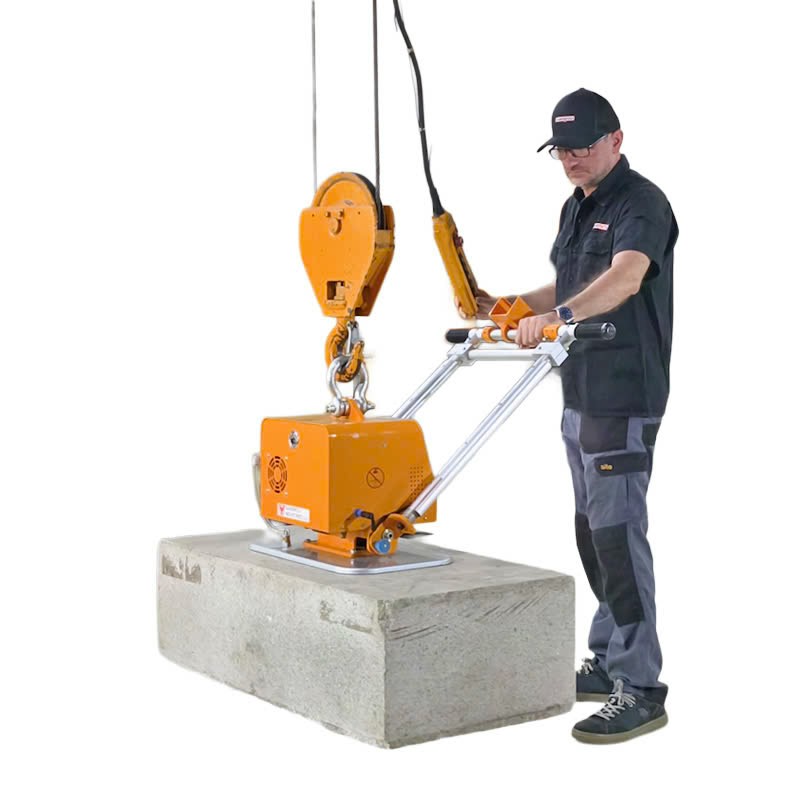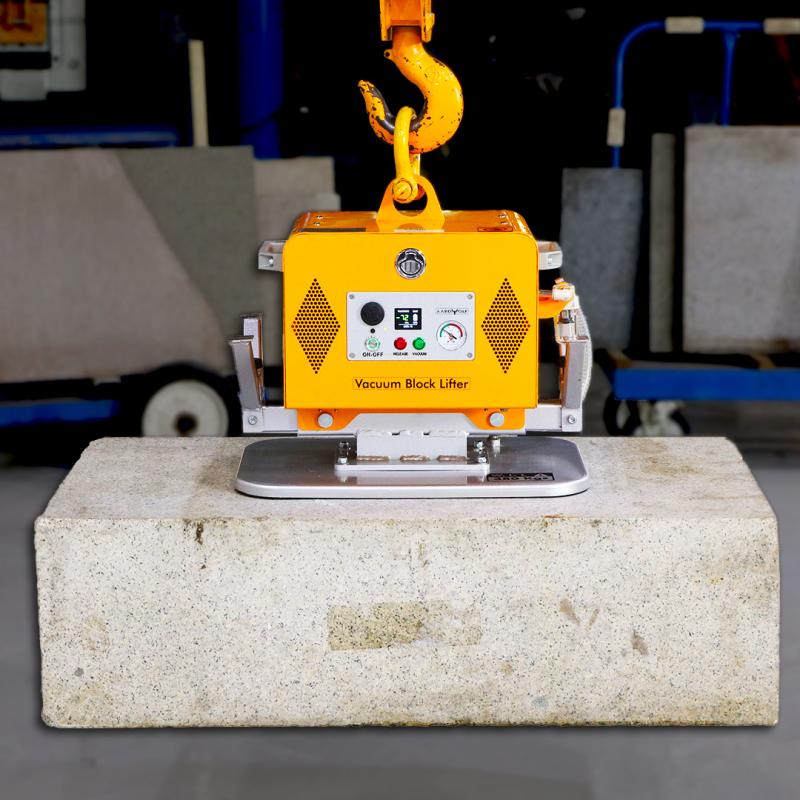



It creates an air-tight seal between a suction cup or suction foot and the surface of a load, enabling the secure transfer of goods without physical lifting. Vacuum lifters are commonly used in logistics, warehousing, manufacturing, and construction environments.
The system typically includes a vacuum pump, a lift tube, suction cups or feet, and a control handle. These components work together to form a lifting mechanism that replaces manual labor and ensures safe and efficient load handling.

Vacuum lifters function by generating a vacuum between the suction cup and the surface of the object. The vacuum pump—either electric or pneumatic—draws air out of the sealed space between the load and the suction cup, lowering the pressure inside the cup. Atmospheric pressure outside the cup pushes the object tightly against the suction surface, creating a strong bond.
Operators use a control handle to regulate the vacuum pressure, allowing for smooth lifting and lowering. The lift tube expands and contracts depending on the vacuum level, providing vertical motion without the need for cables or pulleys.
1. Vacuum Pump: The heart of the system, responsible for generating negative air pressure. It can be powered by electricity, compressed air, or battery.
2. Lift Tube: A flexible conduit that expands or contracts based on vacuum levels, providing vertical movement for the load.
3. Suction Foot/Cups: Rubber or silicone components that grip the load. Their design varies depending on whether the material is solid, smooth, or porous.
4. Control Handle: An operator interface used to lift, lower, and release the load. It includes levers or valves for adjusting vacuum strength.
5. Mounting System: Often includes overhead cranes, jib arms, or mobile carts, depending on the application environment.
A key principle in vacuum lifting is forming an air-tight seal. This prevents air leakage, which can weaken the vacuum and reduce lifting strength. For solid objects like glass panels or stone slabs, small suction cups with rubber gaskets are effective.
For porous items such as paper sacks or fabric bags, larger suction feet with flexible rubber skirts are used to maintain suction. Increased airflow from the vacuum pump is essential in such cases to counteract leakage and maintain a stable grip.
Vacuum lifters are typically mounted on overhead crane systems, which allow the operator to maneuver the load within a defined workspace. For small workstations, a jib crane provides a cost-effective suspension solution.
Mobile vacuum lifters, often mounted on forklifts or pallet jacks, allow workers to navigate large warehouse spaces efficiently. These mobile systems are ideal for order picking, enabling staff to lift items directly from pallet racks and transport them with ease.
1. Power on the vacuum pump to initiate suction.
2. Align the suction cups or foot on the object’s surface. Confirm that an air-tight seal has been created.
3. Use the control handle to lift the load. The vacuum lift tube will rise as pressure decreases.
4. Maneuver the load to the desired location. Use the handle to rotate or position the object as needed.
5. Lower the object gently by adjusting the control lever.
6. Release the load by tilting the suction foot or disengaging the valve to break the seal.
Vacuum lifters reduce physical strain, promote a safer workplace, and allow one operator to handle heavy items effortlessly. This leads to fewer injuries, less absenteeism, and better overall productivity.
They are also inclusive—any employee, regardless of strength, can operate the equipment. This enables a more diverse and flexible workforce.
In logistics and warehousing, vacuum lifters streamline order picking and reduce the risk of product damage, saving time and improving customer satisfaction.
The price of a vacuum lift system depends on the weight and type of items to be lifted, the working environment, and any customizations needed. It’s essential to test the equipment on real loads and assess your facility layout before installation.
We offer full consultation, testing, and professional installation to ensure optimal performance. Their technicians customize the lifter to match workspace needs, ensuring safe and efficient operation from day one.
Real-World Applications of Aardwolf Vacuum Lifters
1. Granite Slab Loading in Stone Fabrication Plants
In countertop fabrication facilities, Aardwolf’s AVLP1-250P and AVLP4-P-1000 models are widely used to lift granite slabs from storage racks and place them onto cutting tables. These lifters help reduce physical strain on workers and minimize the risk of chipping expensive materials during transfer.
2. Architectural Glass Installation on High-Rise Buildings
Aardwolf’s AVGLP8-800 vacuum lifter, designed with 8 suction pads and horizontal/vertical tilting capabilities, is used to install large, tempered glass panels in commercial construction. The built-in alarms and vacuum reserve tank offer critical safety support during complex façade installations.
3. Metal Sheet Handling in Laser Cutting Workshops
The AMMVL1000 mono mechanical lifter allows manufacturers to safely handle and load stainless steel and aluminum sheets onto laser cutters and bending machines. Its 24/7 cycle capacity ensures reliable performance even in continuous production environments.
4. Precast Concrete Slab Placement in Construction Sites
The AVBL-1000 vacuum block lifter is used for moving and placing precast concrete panels in road and infrastructure projects. Its robust suction and ergonomic design help operators install materials quickly while minimizing manual labor.
5. Warehouse Order Picking and Palletizing
Fork-mounted systems like the FMVLA04-2T are commonly employed in distribution centers to pick flat-packed furniture, large cartons, and panel goods from high racks. These lifters, paired with forklifts, boost the speed and safety of order fulfillment.
6. Marble Slab Rotation During Inspection and Polishing
Aardwolf’s tiltable vacuum lifters, such as the AVLP3-600P, are used to rotate heavy marble slabs from horizontal to vertical during quality control and polishing processes. The operator can control tilt and lift using a single handle, reducing the risk of slab cracking.
7. Paver Installation in Landscaping Projects
Compact vacuum lifters like the AVPL40 are used to lay pavers and stones accurately in outdoor spaces. These tools make it easy for one worker to lift and align heavy pavers without damaging the edges or risking injury.

Vacuum lifters are the ultimate solution for safe, ergonomic, and efficient material handling. Whether installed in a manufacturing line, a warehouse, or mounted to mobile equipment, they provide consistent lifting power and reduce operational strain.
With minimal training, workers can master vacuum lifting and significantly enhance workplace productivity. Investing in vacuum technology not only boosts efficiency but also contributes to long-term employee well-being and business success.
1. How to operate a Jib Crane safely
3. Over brace jib crane wall mounted
5. Is a Jib Crane a Gantry Crane
6. Articulated Jib Crane Wall Mounted
8. Manual Counterbalance Crane
10. Over Braced Jib Crane Column Mounted
Sign up to receive the latest info on new Aardwolf products, special offers and more.
By signing up you agree to receive emails from Aardwolf with news, special offers, promotions and other information. You can unsubscribe at any time.